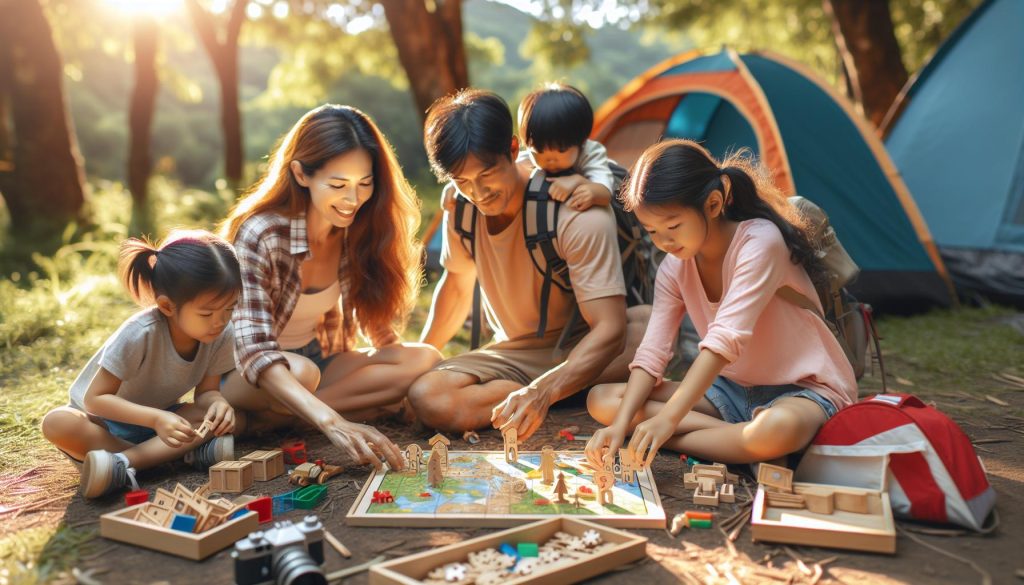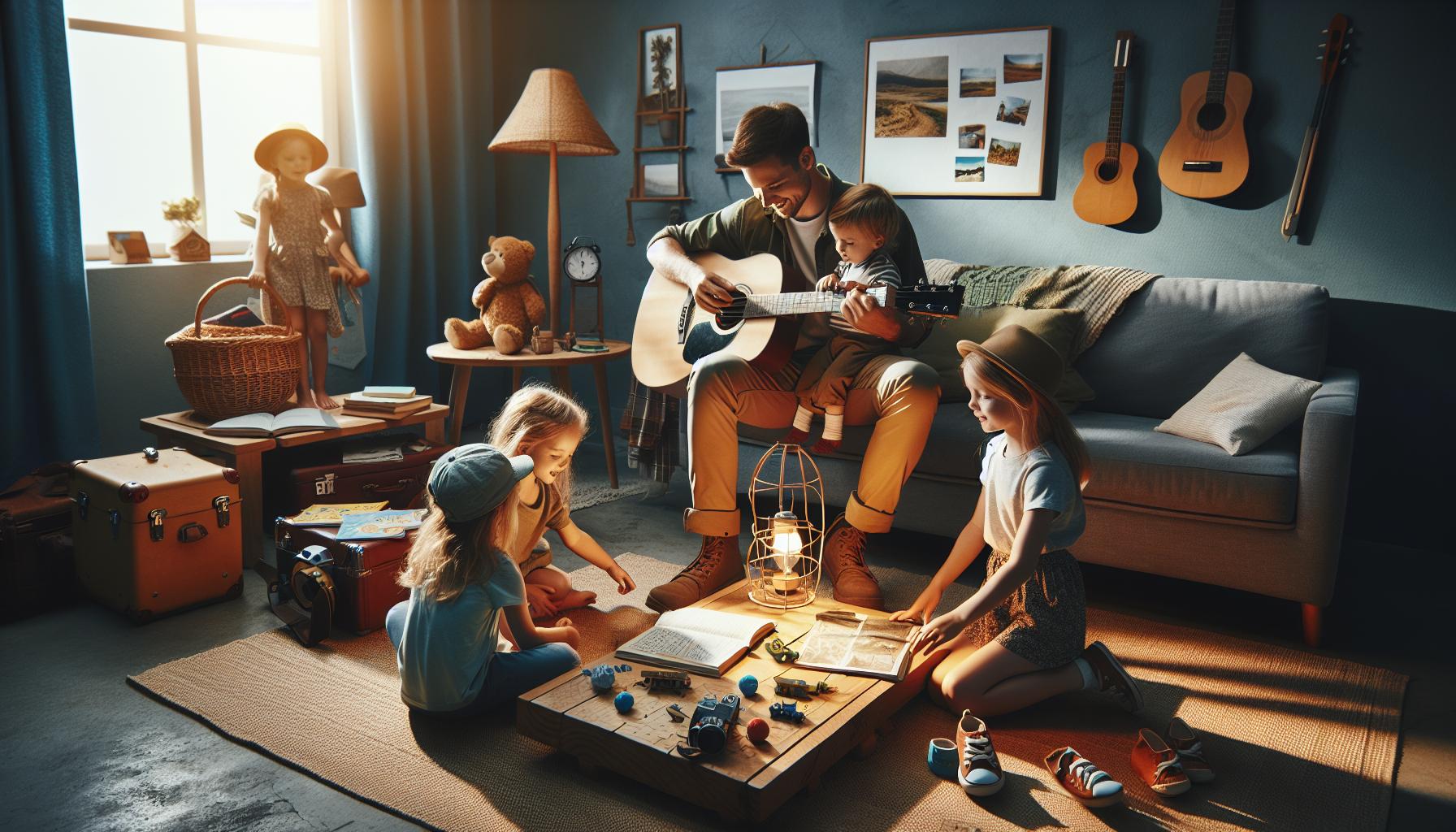Escape Room Ideas for Kids: DIY Games for Creative Minds
Unlock the door too creativity and fun with our ultimate guide on Escape Room Ideas for Kids: DIY Games for Creative Minds! If you’ve ever watched your little ones dive into pretend play and wondered how to harness that infectious imagination, you’re in for a treat. Why settle for another dull afternoon when you can turn your living room into a thrilling adventure zone? Say goodbye to boredom and hello to problem-solving, teamwork, and a sprinkle of excitement—without even stepping outside! With our step-by-step ideas, you’ll discover how to create engaging puzzles and challenges that will have your kids laughing, thinking, and plotting their glorious escape. So grab your detective hats and some crafty supplies—it’s time to embark on a DIY escapade that’ll keep those creative juices flowing and your kids jumping for joy!
creative Themes for DIY Kid-Friendly Escape Rooms
Creating a memorable escape room experience starts with an engaging theme that captivates kids’ imaginations. Here are some inventive themes that can be easily adapted for your DIY setup:
- Treasure hunt Adventure: Set up a pirate-themed escape room where kids must search for clues leading to hidden treasure. Create maps, riddle-based challenges, and treasure chests filled with small toys or candy.
- Science Lab Escape: Transform a space into a mysterious lab filled with “experiments.” Use beakers, colored water, and fun science trivia as clues. Kids can solve puzzles by mixing ingredients accurately to “escape” the lab.
- Space Exploration: Take children on a journey through the galaxy. use glow-in-the-dark stars, spaceship decorations, and space-themed puzzles that require decoding alien languages to navigate their way back to Earth.
- Fairy tale Quest: Incorporate beloved fairy tales by creating challenges around characters and stories they know. Puzzles could include fairy tale trivia, character matching, and story completion tasks.
To further enhance the experience, consider incorporating a few clever puzzles tailored to each theme. Below is a simple table of puzzle ideas for a Treasure Hunt Adventure:
| Puzzle Type | Description | Materials Needed |
|---|---|---|
| Map Decoding | Kids decipher a treasure map with symbols that lead to the next clue. | Paper, markers, treasure map printouts |
| Riddle Challenge | Solve riddles that point to locations for the next clue. | Printed riddles, envelopes |
| Physical Challenge | Complete a task, like a mini-obstacle course, to unlock the final treasure. | Obstacle course materials (cones, ropes, etc.) |
These themes not only encourage teamwork but also foster creativity and critical thinking. By integrating various activities and incorporating feedback from the players, you can refine the setup each time for even more fun!
Essential Supplies and Tools for Your Escape Room setup
Setting up an engaging escape room experience requires a thoughtful selection of supplies and tools that will spark creativity and challenge young minds. Here’s a rundown of some essential items that can definitely help bring your DIY escape room to life:
- Lock Boxes: Utilize combination locks or key locks to create physical puzzles. These boxes can store clues or prizes, making them a focal point of the game.
- Puzzles and Brain Teasers: Incorporate jigsaw puzzles, riddles, or logic puzzles that players need to solve to advance in the game. Printable puzzle sheets can be created to suit your theme.
- Props: Gather an array of themed props like magnifying glasses, old books, or mysterious artifacts. These can enhance the storyline and provide clues embedded within their details.
- Timers: A countdown timer creates urgency and excitement. Use a smartphone app or a physical timer that can be easily seen by all players.
Additionally, consider the following tools for crafting and customizing your escape room environment:
| Tool | Purpose |
|---|---|
| Markers and Art Supplies | To create signs, clues, and decorations that fit your theme, making the experience visually immersive. |
| Digital Devices | Utilize tablets or computers for digital puzzles or clues,adding a tech-savvy twist to your escape room. |
| Sound Effects | Incorporate background music or sound effects to enhance the atmosphere. Free audio clips are available online. |
| DIY Kits | Purchase or assemble DIY kits specifically designed for escape rooms, offering pre-made puzzles and clues for convenience. |
With these essential supplies and tools, you can create an engaging and memorable escape room experience that will challenge and delight young players, fostering teamwork and problem-solving skills in a fun, interactive setting.
Engaging Puzzles and Challenges to Stimulate Young Minds
Creating engaging puzzles and challenges not only entertains children but also sharpens their critical thinking and problem-solving skills. Setting up a DIY escape room can be the perfect way to stimulate young minds, allowing them to dive into a world of mystery and adventure right in the comfort of their own home. Here are some ideas to get you started:
- Treasure Hunts: Create a series of clues leading to a hidden treasure. Each clue can require them to solve a riddle or complete a task before moving on to the next.
- Code Cracking: Introduce diffrent types of codes for kids to decipher. Use simple substitution ciphers or even create a unique code just for your game.
- Physical Challenges: Incorporate activities like balancing tasks, or simple puzzles that require them to use their bodies, such as a mini obstacle course with clues hidden along the way.
- team Challenges: Divide children into teams to solve puzzles constructed around teamwork and collaboration. This can improve their social skills as well as enhance their ability to think critically in a group setting.
To further enhance the experience, consider using themed decorations that match the challenges. For example, if you’re setting up a detective scenario, you can dim the lights, set up props like magnifying glasses, and play an audio track of ambient mystery sounds. This immersive environment encourages creativity and engagement.
| Challenge Type | Key Skills Developed |
|---|---|
| Riddles | Critical Thinking |
| Code Breaking | analytical Skills |
| Physical Tasks | Coordination & Teamwork |
| Collaborative Puzzles | Communication |
These interactive elements not only keep children entertained but also foster skills that they can carry into their educational journey. Emphasizing creativity in the way challenges are presented will make your DIY escape room a thrilling and invaluable learning experience.
Crafting a Captivating Storyline for Immersive Experiences
Creating an engaging storyline for an escape room designed for kids involves a balance of fun, challenge, and imagination. The narrative should be age-appropriate and cater to their interests, drawing them into a world where they can be heroes, detectives, or explorers. Here are some effective strategies to craft a captivating storyline:
- Relatable Characters: develop characters that kids can connect with, such as friendly animals, superheroes, or whimsical fairytale figures. This makes the storyline more engaging.
- Inviting Themes: Choose themes that resonate with children, like space adventures, pirate treasures, or mystical quests. Try to align with popular children’s media for more immediate appeal.
- Clear Objectives: Kids thrive on goals. Establish a mission—whether to save a creature from a trap, find a lost treasure, or break an evil curse—giving them a clear purpose as they navigate the challenges.
- Interactive Elements: Integrate puzzles and challenges that reflect the storyline. For instance, a treasure map could lead to clues hidden in different “islands” within the room, enhancing immersion.
Moreover, engaging visual and audio elements can serve to enhance the narrative experience. Consider the following:
| Elements | Description |
|---|---|
| Visual Decor | Use themed decorations, such as space backdrops or forest canopies, to set the scene. |
| Sound Effects | Include thematic music and sound effects—like ocean waves for pirate scenes—to create an immersive atmosphere. |
| Props | Incorporate engaging props like treasure chests, keys, and maps to make the physical space dynamic and interactive. |
a captivating storyline woven with relatable characters, clear objectives, and rich sensory experiences will not only provide entertainment but also promote problem-solving and teamwork among kids, making your DIY escape room a memorable adventure. By mastering the art of storytelling, you create a magical experience that leaves them looking forward to their next challenge.
Tips for Designing Age-Appropriate Difficulty Levels
When crafting an engaging escape room experience for children, it’s essential to tailor the difficulty of challenges to their specific age group. This not only enhances enjoyment but also keeps frustration levels in check,ensuring that young players remain motivated and involved throughout the game. Here are some effective strategies to ensure the challenges are well-suited for your target audience:
- Understand developmental stages: Children at different ages possess varying cognitive abilities. For instance, younger children (ages 5-7) may thrive with simple puzzles requiring basic counting or matching, while older kids (ages 8-12) can handle more abstract reasoning challenges.
- Incorporate sensory elements: Engage younger participants by using tactile items, bright colors, and sounds. These sensory cues can make tasks more accessible and enjoyable, such as having them search for hidden objects by following a map with visuals instead of text.
- Adjust complexity progressively: Gradually increase the intricacies of the challenges as children navigate through the game. Providing an easier starting point helps build confidence before they tackle more complex tasks, ensuring a balanced gaming pace.
- Utilize teamwork: Designed puzzles that necessitate collaboration can promote social interaction among kids. Team efforts can dilute difficulties, allowing them to share insights and ideas, which fosters both learning and fun.
By keeping these strategies in mind, you can create a dynamic escape room experience that not only captivates but encourages critical thinking and teamwork skills among kids.Here’s a simple table to summarize age-appropriate challenge types:
| Age Group | Suggested Challenge Types | Examples |
|---|---|---|
| 5-7 years | Simple puzzles, scavenger hunts | Color matching, shape sorting |
| 8-10 years | Logic puzzles, riddles | Ciphers, clue-based tasks |
| 11-12 years | Critical thinking challenges | Escape sequences, story-based puzzles |
Incorporating Educational Elements in Escape Room Games
Creating an escape room game provides a unique opportunity to incorporate educational elements that will engage young minds while they solve puzzles and riddles. Here are some effective ways to blend learning with fun:
- Math Puzzles: Integrate addition, subtraction, multiplication, or division problems into your challenges. As a notable example, players can decipher numbers that lead to the next clue by solving basic math questions.
- Reading Comprehension: Use short stories, poems, or fun facts that players must read in order to gather data required to escape. This encourages critical thinking and enhances literacy skills.
- Science Principles: Introduce simple science concepts, such as basic chemistry through color mixing or biology through a nature-themed escape game. Children could uncover clues related to elements like the life cycle of a butterfly.
- History Mysteries: Design puzzles that revolve around ancient events or important figures. For example, clues could be based on famous inventions or notable discoveries, allowing kids to engage with history actively.
In addition to these concepts, consider designing interactive challenges that require teamwork and communication, emphasizing social skills and collaboration.
| activity | Educational Element | Example |
|---|---|---|
| Word Search | Vocabulary Building | Finding terms related to the subject matter. |
| Kahoot Quiz | Knowledge Recap | Answering questions based on stories or facts from puzzles. |
| Physical Challenges | Spatial Awareness | Moving through a maze to collect clues. |
By integrating these educational elements into your escape room theme, you not only create an entertaining experience but also foster a love for learning among children.
Creating a Safe and Fun environment for Group Play
Creating a safe and enjoyable atmosphere promotes not only creativity but also teamwork among kids engaged in group play. Here are some essential components to consider:
- Designated Play Area: Choose a spacious and safe location, free of sharp edges or hazardous materials. An area with ample room for movement enhances engagement and exploration, whether indoors or outdoors.
- Clear Rules: Establish simple, clear rules that everyone understands. This ensures that all participants are aware of what is expected, fostering a sense of security and fairness.
- Supervision: Adult supervision is crucial, especially for younger children. This not only ensures safety but also enhances the play experience through guidance and encouragement.
- Diverse Activities: Incorporate a variety of challenges that cater to different interests and skill levels. This inclusivity encourages participation and keeps everyone engaged.
In addition to safety measures, enhancing the fun aspect can be accomplished through the following:
| Activity | Benefit |
|---|---|
| Team-Based Puzzle Solving | Fosters collaboration and critical thinking. |
| Obstacle Course Challenges | Promotes physical activity and agility. |
| Creative Storytelling | Encourages imagination and verbal skills. |
By focusing on safety and fun, you can create a dynamic environment where children feel secure to express themselves and thrive as they enjoy their playtime. Tailor these strategies to suit the age and interests of the group for optimal enjoyment and learning outcomes.
Frequently Asked Questions
What are the benefits of creating a DIY escape room for kids?
Creating a DIY escape room for kids offers a multitude of benefits that extend beyond just having fun. Firstly, it encourages critical thinking and problem-solving skills. Children are tasked with deciphering clues, figuring out puzzles, and working through challenges, which stimulates their cognitive abilities. Research has shown that actively engaging in such activities can enhance children’s analytical skills and creativity. A study published in the Journal of Educational Psychology highlighted that children who engaged in puzzle-solving tasks improved their logical reasoning skills substantially.
Secondly, a DIY escape room promotes teamwork and communication among kids.When placed in a collaborative environment, children learn how to share ideas, negotiate solutions, and appreciate teamwork. These social interactions are critical for developing emotional intelligence and interpersonal skills. For instance,a group of kids working together during an escape room project often finds that each member brings unique strengths to the table,which fosters a sense of belonging and teamwork.
Lastly, a DIY escape room encourages creativity and innovation. designing a themed escape room allows kids to express their ideas through storytelling, crafting clues, and integrating technology, if they choose. Tap into their imagination by asking them to create a theme based on their favourite book or movie, transforming the experience into a fusion of learning and play.
How can I design an age-appropriate escape room for my kids?
When designing an escape room for kids, it is essential to tailor the difficulty level and type of challenges to their age group. For younger children, such as those aged 5-7, opt for simple puzzles and physical challenges that focus on matching and counting rather than complex riddles.Such as, you could create a treasure hunt where kids must find items based on colors or shapes. Using larger, brightly colored clues can help them engage more effectively.
For older kids, especially those aged 8-12, you can introduce riddles, logic puzzles, and word games. These challenges can include codes to decipher or hiding clues in books. Incorporate elements like timed challenges to add excitement. You might also involve physical components, like having them unlock a box using a combination they’ve figured out through clues scattered throughout the room.
Consider the theme of your escape room, as this can significantly enhance engagement. Themes like “pirate treasure hunt,” “outer space adventure,” or “magical forest” can captivate children’s interests and foster imaginative play.Once you have your theme and age-appropriate challenges set, enlist your kids for feedback on the design—this collaborative effort will ensure the escape room feels personal and exciting to them.
What materials do I need to set up a successful escape room?
Setting up a successful DIY escape room requires a mix of materials that can be easily sourced and creatively utilized. Firstly, you’ll need basic supplies like paper, markers, and scissors. These will allow you to create clues, puzzles, and decorations that match your chosen theme. For example, if you’re going with a pirate theme, crafting clues on aged paper can add an authentic touch.
In addition, consider using storage boxes or locks to create physical challenges. These can be used to securely hold rewards or next clues that kids must solve for. Locks can be combination types or even simple ones that require a key—keys can be hidden around the room. When selecting boxes, make sure they’re durable enough to withstand enthusiastic handling.
Don’t overlook digital elements; incorporating technology can boost engagement. For instance, you can use QR codes that lead to online puzzles or videos which reveal clues when scanned. Statistics indicate that 78% of students respond positively to lessons incorporating technology; this same principle applies to engaging escape room experiences. By combining physical and digital materials, you can create a multi-dimensional play environment that stimulates kids’ creativity and enjoyment.
How can I ensure that kids stay engaged during the escape room experience?
To ensure kids remain engaged during the escape room experience, starting with a captivating storyline is essential. Construct a narrative that draws them in; as an example,a mystery involving “saving the planet from alien invaders” can elicit excitement and curiosity. Provide a clear mission at the beginning that motivates children to solve their puzzles collaboratively. You might even consider providing small rewards or treats as they progress through the challenges, maintaining their momentum.Time limits can also introduce a sense of urgency and thrill, typically appealing to kids’ competitive spirit. For younger children, 30-45 minutes can be sufficient, while older kids may enjoy a more extended challenge. Make sure to supervise the experience without interfering, providing hints when necessary to prevent frustration. Strategic hints can keep the fun flowing and ensure no child feels stuck or left out.
Lastly, allow for team roles during the experience. Designate roles like the clue-finder, puzzle-solver, and lookout, leveraging children’s unique skills and preferences. This will enhance teamwork and ensure everyone has a chance to contribute, making the overall experience more inclusive and enjoyable.
What types of puzzles work best for kids in an escape room?
When it comes to designing puzzles for kids in an escape room, choosing a variety that fosters engagement and supports different skills is crucial. Here are some types that work particularly well:
- Physical puzzles: These require kids to interact with objects. For example, puzzles where they must stack blocks to unlock a combination box can encourage motor skills and teamwork.
- Riddles and word puzzles: Crafting age-appropriate riddles that lead to clues adds an intellectual layer to the escape room. Using rhymes or visual Word Scrambles can enhance engagement, especially if they relate directly to the escape room’s theme.
- Hidden object challenges: Kids can have a great time searching for hidden items that are essential to solving larger puzzles. Such as, a homemade map leading them to various hiding spots can motivate exploration and interaction within the room.
- Logic puzzles: For older kids, logic puzzles such as Sudoku or matching games encourage critical thinking. Incorporate these challenges into the room where they must solve all the challenges to uncover the final clue.
By varying the types of puzzles and incorporating interactive elements, you can maintain high energy levels and excitement, leading to a memorable and fulfilling escape room experience.
How can I include educational elements in my escape room?
Incorporating educational elements into your escape room can transform the experience from merely entertaining to profoundly enriching. First, think about integrating STEAM concepts—Science, Technology, Engineering, Art, and Math—into the puzzles. For instance, if your escape room has a science theme, you could design experiments that need to be solved to unlock the next clue, thereby intertwining scientific principles with problem-solving.
you can also introduce history or geography into your escape room narrative. Design puzzles that require kids to answer trivia questions about historical figures or world locations to progress. incorporating current events or environmentally-focused themes, like conservation, can spark discussions and encourage social awareness among participants.
Moreover, consider integrating language skills through the use of coding languages or logical thinking statements, leading them to practice their literacy skills in a fun way. Kids could decode certain messages written in simple ciphers to reveal the next clue, linking the escape room experience to their schoolwork.
Incorporating these educational elements not only enriches the escape room but can also reinforce what children are learning in school,making it both a compelling and informative activity. These methods encourage active learning in an exciting, immersive manner while preparing them for real-world applications.
Wrapping Up
As we’ve explored, crafting DIY escape room games for kids is not just a fun activity; it’s an opportunity to stimulate their creativity, problem-solving skills, and teamwork. With a bit of planning and imagination,you can create unique adventures right in your living room or backyard. Remember, the key is to tailor your themes and puzzles to the interests and age levels of the participants. Whether it’s a treasure hunt, a mystery to unravel, or a thematic experience tied to their favorite books or movies, the possibilities are endless.
statistics show that interactive play enhances cognitive progress and social skills in children, making these DIY escape room ideas not only entertaining but also beneficial for their overall growth. So gather your supplies, team up with your young adventurers, and let the games begin! With your creative touch, you’ll be sure to create memories that last long after the last puzzle is solved. Happy escaping!




